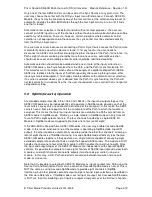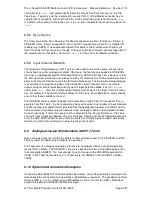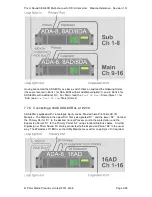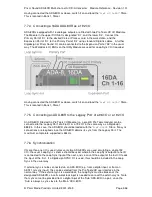
Prism Sound ADA-8XR Multi-channel A/D D/A Converter Module Reference - Revision 1.01
© Prism Media Products Limited, 2001-2005
Page 3.21
Jumpers LK2, LK4, LK6 and LK8 set output impedance, and carrier voltage and grounding for
output carriers one to four respectively. Jumpers LK3, LK5, LK7 and LK9 set the input
impedance for input carriers one to four respectively. The correct jumper configurations to use
for AES3 and S/PDIF modes are shown for input and output.
5.12 Specifications
Transformer-coupled DB25 connector:
AES3 mode:
I/O impedance: 110
Ω
Output carrier amplitude (loaded): 3.2Vp-p
S/PDIF mode:
I/O impedance: 75
Ω
Output carrier amplitude (loaded): 0.5Vp-p
Output Channel Status: Professional or Consumer
Input jitter tolerance:
<200Hz: 15UIp-p
>8kHz: 0.5UIp-p
(1UI = 163ns at fs=48kHz)
One-wire input and output mode supported at all fs from 32kHz to 192kHz
Two-wire (Split96) input and output modes supported at fs=88.2, 96, 176.4 and 192kHz
Wordlength: 16, 20 or 24-bit per channel
Input Channel Status: tolerant; only pre-emphasis indication noted
Output Channel Status implementation:
Professional Channel Status Implementation:
Field
Position
AES3 Module Output
Channel status mode
Byte 0, Bit 0
Professional
Audio Mode
Byte 0, Bit 1
Linear PCM
Encoded audio signal Emphasis
Byte 0, Bits 2-4
Same as input, or no emphasis
Source sample frequency lock
Byte 0, Bit 5
Lock not indicated
Frame rate
Byte 0, Bit 6-7
Indicates current frame rate
Encoded channel mode
Byte 1, bit 0-3
2-channel mode for normal AES3, Single-channel
double fs for Split96
Use of User bits
Byte 1, bit 4-7
No User information
Use of auxiliary sample bits
Byte 2, bit 0-2
Audio sample wordlength
Byte 2, bit 3-5
Set according to channel wordlength
Multichannel mode
Byte 3, bit 7
Undefined multichannel mode
AES-11 Reference signal
Byte 4, bit 0-1
Not a reference signal
Sampling frequency
Byte 4, bit 3-6
Indicates current sampling rate
Sampling frequency scaling
Byte 4, bit 7
No scaling
Channel origin data
Byte 6-9
NULL – no channel origin data






























